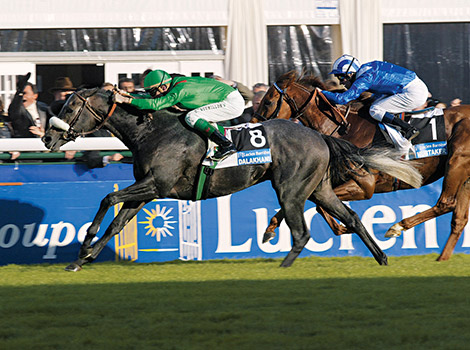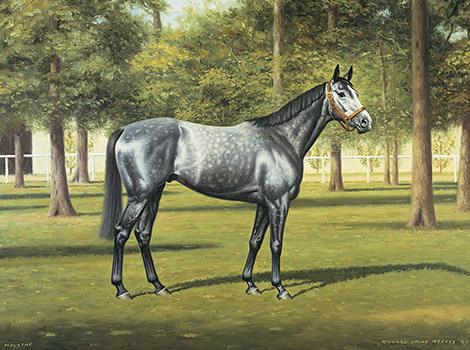


The best of these horses was Darshaan, according to the compilers of the International Classification. In the hands of Yves Saint-Martin, Darshaan wore down Sadler’s Wells by one and a half lengths with Rainbow Quest half a length away 3rd.
"The thoroughbred is what it is because of the Derby" - in this fashion Signor Federico Tesio bestowed his imprimatur on the Epsom Classic. But even he would now have to concede that no 1-2-3 in any twentieth century English Derby could match the subsequent stud achievements of the first three home in the French Derby of 1984.
At the end of his three-year-old career His Highness retired Darshaan to Ballymany Stud and afterwards moved him to Gilltown. Today, his 471 flat winners worldwide include the 2,000 Guineas victor Mark Of Esteem, the Group I Breeders’ Cup Turf winner Kotashaan, and Classic horse and Classic sire Dalakhani, Nonetheless, his primary value to breeders has to be the stud quality of his fillies, for these broodmares have proven an enduring legacy to him. Group/Grade I winners from Darshaan mares include Sendawar, High Chaparral, Islington, Zainta, Sulk, Alborada, Ebadiyla, Edabiya, Astarabad, Enzeli, and more recently Alexander Goldrun, Eagle Mountain, Glass Harmonium, Sarafina, Lillie Langtry, Wavering and Mandaean.
Nowadays, his son Dalakhani has also risen in the ranks as a Classic sire and an aspiring damsire. His Classic winners are Conduit, Moonstone, Chinese White, Duncan and Reliable Man. In the words of Tony Morris, the Racing Post’s breeding expert, in 2010: “I expect him to get plenty of smart performers from all kinds of distaff backgrounds as he has covered quality mares in greater numbers in the past four seasons, his influence is going to grow. He is Northern Dancer-free, which stands him in good stead”.
But now back to 1985 and the Aga Khan’s French Derby winner that year, Mouktar. A highly successful racehorse, Mouktar’s single career defeat took place on fast ground in the Irish Derby. The top two-year-old of his generation in France, Mouktar’s Prix Hocquart win made him the favourite at 1 to 5 in the Prix du Jockey Club and he won accordingly. Two years later Natroun, a supplementary entry, provided Yves Saint-Martin with his final French Derby mount. Pouncing late he caught the subsequent Prix de l’Arc de Triomphe winner Trempolino to score by a head.
Towards the end of 1990 the Aga Khan decided to withdraw his racehorses from England following the disqualification of Aliysa after winning the 1989 Epsom Oaks. Before returning to Ireland he had established a significant presence at The Curragh with John Oxx, which is still on-going. Between 1991 and 1995 the Aga Khan was Ireland’s leading race-winning breeder in the country in statistics that comprised both Flat and National Hunt Racing. This is all the more impressive given that the many winning jumpers bred by him all raced for other owners.
In this review, almost all the great successes were in events with a long history behind them. An exception at the time was the triumph of Lashkari in the first running of the Breeders’ Cup Series in 1984, a concept promoted by John Gaines. Lashkari’s victory in the Breeders’ Cup Turf over All Along, the previous year’s Prix de l’Arc de Triomphe winner, enabled the Aga Khan to become the first European owner-breeder to have his name recorded on this great international register.
The Breeders’ Cup series had its critics from the start. They believed the timing of the fixture so late in the year defeated its objective. The critics were proved wrong - especially where Lashkari was concerned. A descendant of Qurrat-Al-Ain, one of the original foundation mares, he was a late developing three-year-old who only qualified for his place in the race through a mid-October win in the Prix du Conseil de Paris. His Highness later added to his initial Breeders’ Cup success by breeding 1999 Turf winner Daylami and both owning/breeding the 2000 Turf winner Kalanisi.